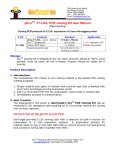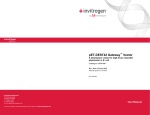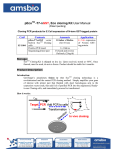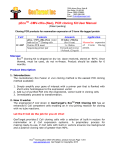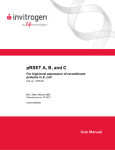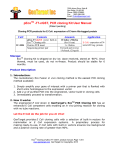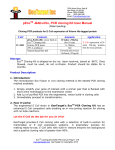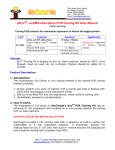Download pEco -T7-cHis, Eco cloning Kit User Manual
Transcript
pEcoTM -T7-cHis, Eco cloning Kit User Manual Cloning PCR products for E Coli expression of N-term His-tagged protein Cat# Contents Amounts Application 10 tubes x 50ul/ea (for 10 rxn) IC-1006 pEco-T7-cHis vector TM built-in Eco Cloning cells Positive PCR insert Sequencing primer pair E Coli expression of C-term His-tag protein. . 1 x 10ul/ea Forward and reverse 15ul/each, (25ng/ul) Storage: EcoTM Cloning Kit is shipped on dry ice. Upon received, stored at -80°C. Once thawed, must be used, do not re-freeze. Product should be stable for 6 months. Product Description: Introduction: GenTarget’s proprietary fusion in vivo (Patent pending) EcoTM cloning technology is a revolutionized and the easiest PCR cloning method. Simply amplifies your gene of interest with primer pair that flanked with short homologous arm to the expression vector ends, then add 1ul of purified PCR into the engineered, Ready-to-use Cloning cells, and immediately proceed to transformation. How it works: Target PCR Add PCR to cells Transformation n ti o c In vivo cloning le e S TM Eco Cloning pEco-T7-cHis manual, Page 1 of 8 Gentarget’s EcoTM PCR Cloning Kit utilizes an engineered E Coli strain with enhanced homologous recombination machinery for an In Vivo end-homologous jointing reaction between PCR product and vector. The vector was pre-processed with the cloning cell using a proprietary protocol to obtain high cloning efficiency and low background. It does not need any kinds of In Vitro tube reaction, such as ligation, Topo jointing or In-fusion reaction, and so on. Let the E Coli do the job for you In Vivo! pEco-T7-cHis cloning cells was built-in with a pET based T7 expression vector. PCR insert will be cloned in-framed with a C-terminal His-tag. Key Features: 1. The most cost effective and the easiest PCR cloning method, simply add 1ul of PCR insert into provided cells for transformation regardless of the insert’s size and concentration; 2. No need to buy expression vectors. The vector was built-in with cloning cells; 3. No need to buy cloning competent cells. The cloning cells is the competent cells; 4. No need for the tedious bench works for preparing vector backbone; 5. No need for any enzymes or any tube reactions; 6. Precisely directional cloning of PCR products in frame with C-term His tag; 7. Flexible to add any cleavage site for removal of C-term His if desired; 8. High efficient (>90% positive rate) and low background; 9. Works fine with any PCR products with or without a 3'-end’s -A overhung (the extra –A overhang, if exists, will be removed in cloning step); 10. Good for different PCR sizes, from 200bp to 6 kb. 11. Engineered E Coli and mammalian expression vectors for high protein yields; 12. Great for high through-put cloning; Protocol Outline: Produce PCR products and clean them Add 1~2ul of PCR product into provided Cloning cells, Briefly mixing and immediately proceed to transformation Pick colonies and miniprep plasmids to verify the positive clones Protein expression from sequencing verified clones TM Eco Cloning pEco-T7-cHis manual, Page 2 of 8 Detailed protocols: 1. PCR primer design: The PCR primers, used for generating inserts for EcoTM Cloning must contains a 20 ~ 25bp homologous sequences corresponding to the built-in vector. Design your primer pair as follows: Fwd: 5’- tttgtacaaaaaagcaggcacc + 20bp of (5’end gene specific forward sequence) Rev: 5’- tttgtacaagaaagctgggtt + 20bp of (3’-end gene specific reverse sequence) Protein cleavage site may be included in reverse primer to allow removal of the C-term tag if desired. Its codon sequences must be in frame and set between the homologous leader and the 20bp gene specific sequence. An example for PCR primer design: To design the primer pair for the following gene sequence: atggcctctgtgaaggaaaatccactctagtccctacctgcatttctcagccttgcttacctgttg ccaacattgggccaacccgaattcttcccaatctttatcttggctgccagcgagatgtcctcaac aaggagctgatgcagcagaatgggattggttatgtgttaaatgccagcaatacctgtccaaagc ctgacttttta Its PCR primer for vector pEco-T7-cHis will be: Fwd: 5’- tttgtacaaaaaagcaggcaccatggcctctgtgaaggaaaa Rev: 5’- tttgtacaagaaagctgggttaaagtcaggctttggacagg In the case of inserting a protein cleavage site, the Rev primer will be: Rev: 5’- tttgtacaagaaagctgggttNNNNNNaaagtcaggctttggacagg (where the NNNNNN is the in-framed, cleavage site codon reverse sequence). Note: 1. Gentarget’s different Gentarget cloning kits share same PCR Insert. For example, the three EcoTM cloning cells, Cat# IC-1001, IC-1002 and IC1003 can use the same PCR to make different expression clones. And other three cloning cells (Cat# IC-1005, IC-1006 and IC-1007) can use the same PCR product for making different expression 2. Do not include the Stop codon in the Rev primer. The stop codon is placed behind the C-term His-tag from the vector. TM Eco Cloning pEco-T7-cHis manual, Page 3 of 8 2. Target amplification by PCR: Using any PCR amplification protocols that work for you to amply your targets. To minimize the PCR errors, we recommend using high fidelity DNA polymerase. Using any PCR purification column to clean your PCR products. If you do not obtain a single, discrete band from your PCR, you need gel-purify your fragment. Important: if your PCR template can generate background clones (having Amp resistance), you need treat your PCR product by DPNI or do gel purification of PCR product. 3. Transformation: Thaw EcoTM Cloning cells in ice-water. After completely thawed, add 1~2ul purified PCR product (from 20ng to 150ng) into each vial of cells, brief mixing by taping the tube with your finger. For control vials, add 1ul positive PCR-insert (provided) as positive control, and add 1ul water to a a negative control vial cells. Put tubes back on ice, and then proceed for heat shock at 42oC for 40 seconds (Note: Do not leave DNA-cells mixture on ice for prolonged period, less than 15min are fine). Put tubes back on ice for 1 min, add 250ul of SOC medium, incubated at 37oC, shaking for 1hr. Plating: take 50ul~200ul aliquot, spread out on pre-warmed LB-agar plates containing100µg/ml ampicillin. And grow colonies at 37oC incubator for overnight. Note: usually in the absence of PCR-insert, cells force some background colonies; the no-insert negative control generates a few colonies. But in the presence of PCR-insert, greater than 90% colonies are positive. Colony number varies dependent the quality and quantity of PCR products. The concentration of purified PCR product can be from 20ng/ul to 150ng/ul with sizes from 200bp to 10kb. For the simplicity and high through-put cloning purpose, we recommend simply add 1-2ul of PCR into cloning cells regardless of the PCR’s concentration and sizes, it will generate enough colonies (5 ~ 100 colonies in general) for downstream works. 4. Verification of positive clones: Pick 2-5 colonies, propagate in LB/Amp, incubate at 37oC overnight; Isolate the plasmid DNAs using DNA miniprep kit (such as Eco™ Plasmid DNA Miniprep Kit, Cat# DP-100). TM Eco Cloning pEco-T7-cHis manual, Page 4 of 8 Confirm the positive by restriction digestion: PCR inset can be cut out by BsrGI: Run 1.2% agarose, two bands: 5.79 kb backbone + the PCR insert (or multiple bands if BsrGI has extra cuts within the PCR-insert). Final sequencing verification: Use provided sequencing primer pair (Note: sequencing primer was provided as ready-to-use dilution, use 1ul for each sequencing reaction with 500ng plasmid in 20ul volume). Cat # IC-1006 Vector pEco-T7-cHis Forward primer IC-1006-fwd 5’- taatacgactcactataggg Reverse primer IC-1006-rev 5’- tgctagttattgctcagcgg 5. Protein expression: Transformation: transform the sequencing verified plasmid DNA into any strain containing a T7 RNA polymerase, such as BL21(DE3) or BL21(DE3)pLys from which protein are expressed upon IPTG induction. Transformation uses standard heat-shock protocol, such as add 1ul DNA into 50ul competent cell, set ice (5~15min), heat-shock at 42oC for 30 seconds, back to ice for 2min, add 250ul SOC, recovery at 37oC, shaking for 1 hour. Plate 10 to 100ul onto LB plates containing 100ug/ml ampicillin. Grow colonies at 37oC incubator for overnight; Propagation: Pick one clone, grow in LB medium with ampicillin at 37oC, shaking overnight. Add overnight culture into appropriate amount of LB medium containing 100ug/ml of ampicillin by making 1:40 dilution, keep medium volume at 20% of flask volume for better aeration, vigorously shake at 30oC, 300rpm; Induction: measure growth OD600, at the time when OD600= ~ 0.5, add an appropriate amount of IPTG, continue grow for 17 ~ 24 hours with vigorously shaking at 30oC, 300rpm; [Note: for best expression results, use Gentarget’s auto-induction medium, EcoTM RichMedium (Cat# RM1000) for propagation, it does not need to add IPTG for induction]. Harvest cells by centrifugation. QC: Cell pellet was lysed using lysis reagent, [Note: we recommend use Gentarget’s EcoTM Buster protein extract reagents (Cat# EB-S100 or EBL100)]. Following the lysis protocols, run protein gel for analysis; Purification: use your favorite protocols and reagent to purify the expression His tagged protein by His-tag affinity column; Purity and function analysis of the expressed protein using your favorite protocols. TM Eco Cloning pEco-T7-cHis manual, Page 5 of 8 Vector maps: The figure below summarizes the vector map of pEco-T7-cHis. Request the complete nucleotide sequence at [email protected]. To make your clone map, simply paste your gene sequence (not included the flanking sequences of both ends) in the Red highlighted position (replacing the NNNN..NN). In most case, the pasted sequence is: “ATG…to...last codon”. Cloning site for pEco-T7-cHis vector T7 promoter 301 TCTCGATCCC GCGAAATTAA TACGACTCAC TATAGGGGAA TTGTGAGCGG AGAGCTAGGG CGCTTTAATT ATGCTGAGTG ATATCCCCTT AACACTCGCC 351 ATAACAATTC CCCTCTAGAA ATAATTTTGT TTAACTTTAA GAAGGAATAT TATTGTTAAG GGGAGATCTT TATTAAAACA AATTGAAATT CTTCCTTATA 401 CACAAGTTTG TACAAAAAAG CAGGCACCNN NNNNNNNAAC CCAGCTTTCT GTGTTCAAAC ATGTTTTTTC GTCCGTGGNN NNNNNNNTTG GGTCGAAAGA BsrGI PCR Insert BsrGI TGTACAAAGT GGTGATCAAT TCGAAGCTTG AAGGTAAGCC TATCCCTAAC ACATGTTTCA CCACTAGTTA AGCTTCGAAC TTCCATTCGG ATAGGGATTG 6His CCTCTCCTCG GTCTCGATTC TACGCGTACC GGTCATCATC ACCATCACCA GGAGAGGAGC CAGAGCTAAG ATGCGCATGG CCAGTAGTAG TGGTAGTGGT TTGAGTTTGA TCCGGCTGCT AACAAAGCCC GAAAGGAAGC TGAGTTGGCT AACTCAAACT AGGCCGACGA TTGTTTCGGG CTTTCCTTCG ACTCAACCGA TM Eco Cloning pEco-T7-cHis manual, Page 6 of 8 Trouble shooting: Problems Solution No colony Be sure to set up a positive control transformation using provided positive PCR insert1, which should give you 10~100 colonies; Spread all transformation mixture on plate; Background colonies Be sure to set up a background control plate in which no PCR was added into cells, it should generate 0 ~ 5 colonies or less than 10% compared to plates with insert (Noticed: in the absence of PCR insert, cells forces vector selfligation resulted in a few background colonies). Make sure that the PCR’s template do not cause background colony; If it does, clean PCR products by gelisolation or treated by DPNI; Plate less transformation mixture on plate; Be sure to use right amount of antibiotics in LB plate, and make fresh LB plates if necessary; Use carbenicillin instead of ampicillin if applicable; Do not incubate plates longer than 16 hours; At colony pick, try to avoid the tiny satellite colonies; Satellite colonies TM Eco Cloning pEco-T7-cHis manual, Page 7 of 8 Related Products: Cat# DP-100 CC03 CC03p RM1000 EB-S100 EB-L100 Product Name Eco™ Plasmid DNA Miniprep Kit Eco™ E Coli expression Competent Cells Eco™ Expression RichMedium Eco™ Buster E Coli protein extraction reagent Amount 100 miniprep 20 rxn/pack 1000ml/ea 100ml/ea IC-1001 PCR cloning kit kit IC-1002 PCR cloning kit kit IC-1003 PCR cloning kit kit IC-1004 PCR cloning kit kit IC-1005 PCR cloning kit kit IC-1007 PCR cloning kit kit Application High pure Plamsid DNA isolation Competent cells for T7 vector protein expression Auto-induction, High yield protein expression medium Protein extraction from cell pellets PCR cloning kit with a built-in vector (T7 promoter based) in provided cloning cells for E Coli expression of N-term His-tagged protein. PCR cloning kit with a built-in mammalian expression vector (with neomycin selection marker) in provided cloning cells. The vector containing an engineered super CMV promoter for high-yield mammalian expression of N-term His tagged protein PCR cloning kit with a built-in vector (non-T7 promoter based) in provided cloning cells for E Coli expression of N-term His-tagged protein, specially designed for toxic proteins. PCR cloning kit with a built-in vector (T7 promoter based) in provided cloning cells for E Coli expression of N-term GST-tagged protein. PCR cloning kit with a built-in Gateway Entry vector in provided cloning cells for making your target in Gateway Entry clone without using BP clonase PCR cloning kit with a built-in mammalian expression vector (with Neomycin selection marker) in provided cloning cells, for mammalian expression of C-term His-tagged protein. References: 1. 2. 3. Oliner et al., 1993, Nucleic Acids Res. 1:5192-97 Aslanidis et al., 1994, Genome Res. 4 :172-177 Kaluz et al. Nucl. Acids Res..1992; 20: 4369-4370 TM Eco Cloning pEco-T7-cHis manual, Page 8 of 8








